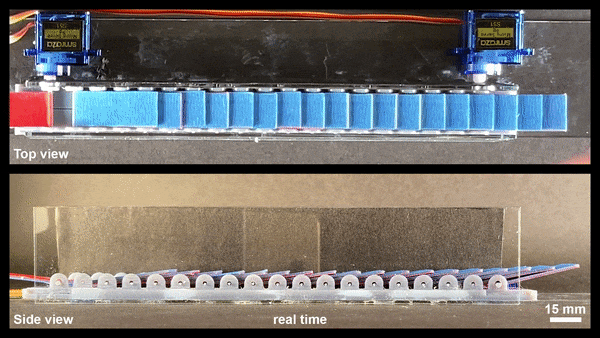Biological actuators can be fantastically complex. Networks of nerves can drive tiny muscles to make coordinated motions in ways that are very difficult for engineered systems to match. You can see how far robotics is from nature when you look at our best attempts to mimic things like snakes or millipedes or even intestines, all of which function based on lots of tiny muscles working together. Usually, the closest that robots can get to nature is by connecting a bunch of chonky discrete actuators together, which sometimes results in similar functionality but with far less efficiency and elegance.
What these biological systems have in common is peristalsis—a series of wavelike coordinated muscle contractions that animals use to move themselves, and that animal insides use to move stuff around. Take just one solitary wave and you’ve got a soliton, which should probably not be used to propel starships at faster-than-light speeds. Solitons have been mimicked by robotic systems before, although by (again) relying on a complicated and expensive chain of individual actuators.
A recent paper from the Pikul group at the University of Pennsylvania is exploring a much simpler approach to generating soliton waves: dominoes.
Falling dominoes exhibit soliton behavior as they topple in sequence, and you can propagate the wave with a single actuator at the first domino. Using some of those fancy “cheating” dominoes that are hinged at the bottom allows a second actuator to send the soliton right back again, resetting the system. “We wanted to realize a system that would be low power, simple, and could scale to smaller robots,” Penn’s James Pikul tells IEEE Spectrum. “Yichao Shi, the first author, was the one who connected the elegant movement of dominoes as a path towards realizing a wavelike motion in a robotic actuator. As we played with the form factors of the dominoes, we were surprised by how complex the wave shape can be programmed, yet how simply the system is actuated.”
Programming a wave shape with dominoes involves adjusting their physical parameters, like domino height and how close each domino is to its neighbor. Depending on what you want your domino actuator to do, the wave shape is easily adjustable at fabrication time, and the researchers performed a series of practical(ish) experiments to see how effective their actuator could be. First, a sort of conveyor that can push objects in front of the soliton to move them along arbitrary paths:
In addition to moving objects with soliton waves, they’re also used in nature by animals for motion, so the researchers built themselves a soliton-powered mantis shrimp robot that uses cascading domino “fins” (that actually look kind of similar to the fins on the animal) combined with footlike things to provide anisotropic friction that results in forward propulsion:
For comparison, here’s a picture of a real mantis shrimp; see if you can spot the soliton wave:

Cool, right?
For more details, we interviewed James Pikul and Yichao Shi via email.
How does the peristaltic motion of the actuator you’ve developed differ from biological models?
James H. Pikul & Yichao Shi: Since our synthetic muscles are less powerful and efficient than animal muscles, we didn’t see coordinated actuation of multiple individual synthetic muscles as an effective way to realize our goals. So, in our system, all the dominoes are linked and constrained by mechanical contact so that they create a soliton with a single signal that is sent to the boundary domino. The advantage of this approach, where only the boundaries have actuators, is that the system is easier to control and build than systems that more precisely mimic biology, and the mechanical constraints make the cascading dominoes easy to apply to different scales. However, the lower degrees of freedom also mean the dominoes have limits in how robust and agile they can be. It is difficult, for example, to push multiple objects through the cascading dominoes at once, or to push liquids. In addition, the dominoes are hard, and although they can be made flexible, the synthetic system is not as compliant as the natural systems.
Can you elaborate on some of the advantages of a cascading domino actuator relative to other common robotic methods of moving objects, like belt conveyors or roller conveyors?
Pikul/Shi: Common automated conveyor systems usually require multiple actuators and separate segments to achieve nonlinear delivery paths. In comparison, our cascading dominoes can realize complex paths with both curvature and elevation changes while being actuated by a single actuator. The cascading dominoes can also be lightweight, flexible, and actuated by a variety of soft actuators (for example, shape memory alloys, inflatable actuators, bending actuators, etc.), whereas conveyor systems are operated by electric motors.
Are there different tasks that the different wave shapes could be optimized for?
Pikul/Shi: In our paper, we show how the force, speed, and aspect ratio (or quality factor) of the wave can be adjusted with small changes in geometry. Having a wave that accelerates at the end of motion, instead of having a uniform wave speed, could be better for launching a projectile or jumping, whereas a uniform wave speed is better for maintaining a constant walking speed. In addition, the aspect ratio of the wave can be tuned for the type of object that is being moved or even for the type of terrain that the robot is moving across. All of these options allow for tunability, which is critical for many robotic designers.
Wave propagation can be used for a wide variety of applications beyond moving objects. One interesting application could be swimming robots, because many aquatic organisms, from flagella in bacteria to eel and tuna swimming, flex their bodies in a wave to displace water and move forward. Modifying the wave shape could also change the way energy or information is transferred through mechanical systems, which could be useful for mechanical metamaterials.
What kinds of potential applications do you think this research could eventually be applied toward in a useful and practical way?
Pikul/Shi: As we have demonstrated in the paper, the cascading dominoes show effective movement of objects, even with multiple objects or through a complex path, and they can provide a simple tool for locomotion. We think this will be most useful in applications that benefit from low cost or disposable systems, such as swarm robots or single-use robots, or applications that cannot accommodate the complexity of many actuators, such as small-scale robots or mass-produced products, such as toys. In addition to wave propagation, our cascading dominoes provide an alternative to classic linkages or gears for force transmission.
What are you working on next?
Pikul/Shi: Our ambition is to develop an “organ” for robots that allow them to eat objects in the environment and electrochemically convert the chemical energy of those objects into usable electrical power. Realizing these cascading dominoes is a first step in this direction because it allows us to transport food through an internal synthetic digestive system.
We did ask for some extra detail on that last bit, and we’re relieved to be able to report that the “objects” in question are metallic, so it might be a little less questionable to say that the robot is consuming local resources rather than eating in an organic way. This is based on recent research the Pikul group has done on metal-eating robots, and not on this scary DARPA project. Phew!
“ Harnessing Cascading Dominoes for Peristaltic Wave Motion,” by Yichao Shi, Zhimin Jiang, and James H. Pikul from the University of Pennsylvania, is published in IEEE Robotics and Automation Letters.
This article appears in the August 2022 print issue as “Robotic-Actuator Problem Topples Like Dominoes.”
Evan Ackerman is a senior editor at IEEE Spectrum. Since 2007, he has written over 6,000 articles on robotics and technology. He has a degree in Martian geology and is excellent at playing bagpipes.



